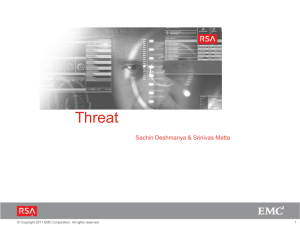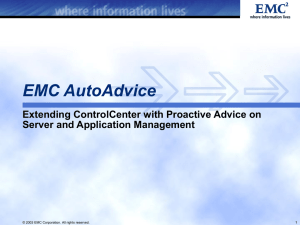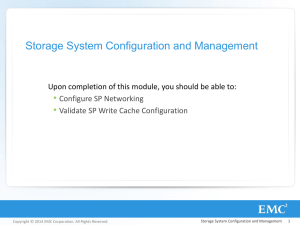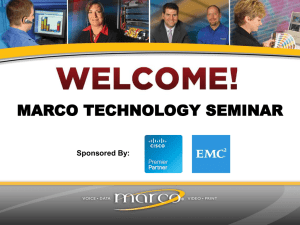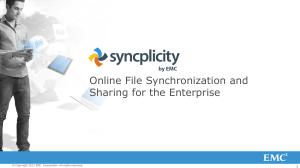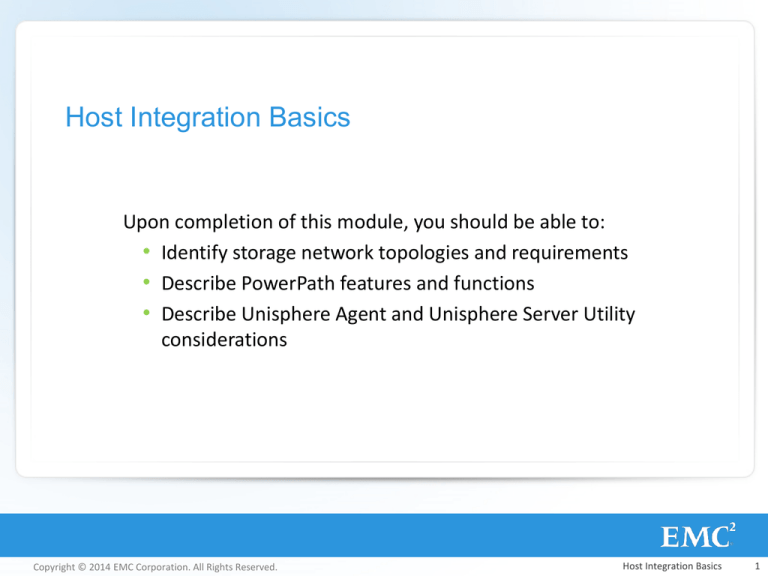
Host Integration Basics
Upon completion of this module, you should be able to:
• Identify storage network topologies and requirements
• Describe PowerPath features and functions
• Describe Unisphere Agent and Unisphere Server Utility
considerations
Copyright © 2014 EMC Corporation. All Rights Reserved.
Host Integration Basics
1
Host Integration Basics
Lesson 1: Storage Network Topologies and Requirements
This lesson covers the following topics:
• Identifying Network Technologies
• Identifying Fibre Channel components, addressing, and
Connectivity rules
• Identifying iSCSI components, addressing, and Connectivity
rules
• Explaining host connectivity requirements
Copyright © 2014 EMC Corporation. All Rights Reserved.
Host Integration Basics
2
Network Technologies
Network technologies offer more flexibility and distance
capabilities than typical channel technologies
Some characteristics of network technologies are:
•
•
•
•
•
Low performance
High protocol overhead
Dynamic configuration
Long distance
Connectivity among
different systems
Copyright © 2014 EMC Corporation. All Rights Reserved.
Host Integration Basics
3
Storage Area Network Management
• SANs are networks of host and storage devices often connected
•
over Fibre Channel Fabrics
A common method of managing the variety of devices on a SAN
is SNMP
Out of Band
• The FibreAlliance is defining the SNMP MIB to facilitate SAN
management
The Fibre Channel Management Integration (FCMGMT-INT) MIB
provides a heterogeneous method of managing multiple devices
across a SAN
Copyright © 2014 EMC Corporation. All Rights Reserved.
Host Integration Basics
4
Fibre Channel
• Fibre Channel is a serial data transfer interface
Copper Wire Connection
Optical Fiber Connection
• High-speed is obtained through:
Mapping networking and I/O protocols to Fibre Channel constructs
Encapsulating them and transporting them within Fibre Channel frames
Host Bus Adapters
Windows
Host
Linux
Host
Copyright © 2014 EMC Corporation. All Rights Reserved.
Storage
Fibre Channel
Switch
Host Integration Basics
5
Host Bus Adapter (HBA)
A Host Bus Adapter is an I/O
adapter that sits between the
host computer's bus and the
Fibre Channel loop
• Manages the transfer of information
Performs many low-level
interface functions
automatically
• Minimizes the impact on host processor performance
•
•
•
•
Multiple Technologies
The HBA enables a range of
high-availability and storage
management capabilities
Copyright © 2014 EMC Corporation. All Rights Reserved.
•
•
•
•
Fibre Channel
iSCSI
FICON
SCSI
Load balance
Fail-over
SAN administration
Storage management
Host Integration Basics
6
Fibre Channel Addressing
• Fibre Channel Addresses are required to route the frames from
•
source to target
24 bits (3 bytes) physical addresses are assigned when a Fibre
Channel node is connected to the switch (or loop in the case of
FC-AL)
Target
FC Switch
Source
FC Initiator:
HBA
Copyright © 2014 EMC Corporation. All Rights Reserved.
FC Responder:
SP Ports
Host Integration Basics
7
Viewing SP Fibre Channel Port Properties
Copyright © 2014 EMC Corporation. All Rights Reserved.
Host Integration Basics
8
Switched Fabric Topology
• Switched Fabric is a Fibre Channel topology where many devices
connect with each other via Fibre Channel switches
This topology allows for the most number of connections with a
theoretical 16 million devices per Fabric
• Frames are routed between source and destination by the Fabric
Fibre Channel
Switch
Copyright © 2014 EMC Corporation. All Rights Reserved.
Host Integration Basics
9
Single Initiator Zoning
• Always put ONLY one HBA in a
•
•
•
zone with Storage ports
Each HBA port can only talk to
Storage ports in the same
zone
HBAs & Storage Ports may be
members of more than one
zone
HBA ports are isolated from
each other to avoid potential
problems associated with the
SCSI discovery process
Copyright © 2014 EMC Corporation. All Rights Reserved.
Single Emulex HBA zoned to two VNX ports
Host Integration Basics
10
iSCSI Overview
iSCSI
• An IP-based protocol for establishing
and managing connections between
IP-based storage devices, hosts, and
clients
• A method to transfer block data using
a TCP/IP network
• Works by wrapping SCSI commands
into TCP Packets to transport them
over an IP network.
• Route or switch on standard Ethernet
equipment.
• Can use existing TCP/IP infrastructure
• Bridging devices can be used between
IP network and SAN
• No Fibre Channel content needed
Copyright © 2014 EMC Corporation. All Rights Reserved.
IP Network
IP Network
iSCSI/FC
Gateway
FC
Host Integration Basics
11
iSCSI Device Options
Network Interface Card (NIC)
• Checksum offload
• Fragmentation, out of order packets handled
by host
• Could hurt system performance
NIC with TCP Off-load Engine (TOE)
• Full TCP/IP offload
• Fragmentation, out of order packets handled
by TOE
• Increased memory/processing requirements
• iSCSI & SCSI handled by host
iSCSI Host Bus Adapter (HBA)
• Full TCP/IP+iSCSI/SCSI
• Completes storage connection
• Runs all layers on HBA
Copyright © 2014 EMC Corporation. All Rights Reserved.
Host Integration Basics
12
iSCSI Names
• An iSCSI address
Uniquely identifies nodes
There are Two variations
iqn. – iSCSI Qualified Name
iqn.1992-04.com.emc:cx.fcntr073900083.a4
eui. – Extended Unique Identifier
eui.5006016141e0163a
Copyright © 2014 EMC Corporation. All Rights Reserved.
Host Integration Basics
13
iSCSI Front-end Port Properties
Copyright © 2014 EMC Corporation. All Rights Reserved.
Host Integration Basics
14
iSCSI CHAP Security
• Challenge Handshake Authentication Protocol
CHAP Target sends challenge to CHAP initiator
2. Initiator responds with a calculated value to the target
3. Target checks the calculated value, and if it matches, login
continues
4. If mutual CHAP is enabled, initiator will authenticate target using
the same process
1.
• One-way and Mutual CHAP
Target and Initiator configured the same
• Configuration
Unisphere – Array
Host NBAs – Vendor Specific Tools
Copyright © 2014 EMC Corporation. All Rights Reserved.
Host Integration Basics
15
iSCSI Network Requirements
• LAN configuration allows Layer 2 (switched) and Layer 3 (routed)
networks
Layer 2 networks are recommended over Layer 3 networks
• The network should be dedicated solely to the iSCSI
configuration
For performance reasons EMC recommends that no traffic apart
from iSCSI traffic should be carried over it
If using MDS switches, EMC recommends creating a dedicated
VSAN for all iSCSI traffic.
The network must be a well-engineered network with no packet
loss or packet duplication.
vLAN tagging protocol is supported
Copyright © 2014 EMC Corporation. All Rights Reserved.
Host Integration Basics
16
iSCSI Basic Connectivity Verification
• Ping
Check basic connectivity
• Trace Route
Provides information on number of hops required for the packet to reach
its destination
Copyright © 2014 EMC Corporation. All Rights Reserved.
Host Integration Basics
17
iSCSI and FC Host Connectivity Rules
• All connections from a host to an array must use the same
protocol
Connections must be all FC or all iSCSI
NIC and HBA iSCSI connections cannot be mixed in the same server
A server must have all NIC iSCSI connections or all HBA iSCSI
connections
Do not connect a single server to both an FC storage system and
an iSCSI storage system
• Servers with iSCSI HBAs and servers with NICs can connect to the
same iSCSI storage system
Copyright © 2014 EMC Corporation. All Rights Reserved.
Host Integration Basics
18
Host Integration Basics
Lesson 1: Summary
During this lesson the following topics were covered:
• Identifying Network Technologies
• Identifying Fibre Channel and iSCSI components and
addressing
• Explaining FC and iSCSI connectivity rules
• Explaining host connectivity requirements
Copyright © 2014 EMC Corporation. All Rights Reserved.
Host Integration Basics
19
Host Integration Basics
Lesson 2: PowerPath and Other Host Utilities
This lesson covers the following topics:
• Describe PowerPath Features and Functions
• Describe Unisphere Agent and Unisphere Server Utility
Considerations
• Implement Host Utilities
Copyright © 2014 EMC Corporation. All Rights Reserved.
Host Integration Basics
20
PowerPath
Host-Based Software
• Provides Path Management
Multiple Storage System Support
Multiple OS Support
Supports Fibre Channel and iSCSI
Copyright © 2014 EMC Corporation. All Rights Reserved.
Host Integration Basics
21
Features and Functionality
Automatic path failover and path restore
•
•
•
•
•
HBA/NIC
Interconnect
Switch
Interface
Interface Port
Dynamic multipath load-balancing
• Host by Host basis
Copyright © 2014 EMC Corporation. All Rights Reserved.
Host Integration Basics
22
Array and OS Support
Supports all EMC-branded storage arrays
• All currently-shipping and supported models of VNX
• Both Fibre Channel and iSCSI interconnects
Supports several third-party, non-EMC storage arrays
•
•
•
•
•
•
IBM ESS (Shark)
Hitachi Lightning
HP-branded Hitachi (HPXP)
HP StorageWorks EVA
EMA
HSG80
Supports major host operating systems
•
•
•
•
Solaris
Windows Server
HP-UX
Linux Enterprise (Red Hat and SUSE)
Copyright © 2014 EMC Corporation. All Rights Reserved.
Host Integration Basics
23
Integration with Volume Managers
Logical Volumes reside above native devices and
PowerPath devices in the I/O stack
PowerPath has been qualified for compatibility
with most major third-party volume managers
•
•
•
•
Solstice Disk Suite, Veritas, VCS on Solaris
Veritas, native LVM on HP-UX
Veritas, native LVM on AIX
Sistina LVM on Linux
Copyright © 2014 EMC Corporation. All Rights Reserved.
Host Integration Basics
24
Device States
A native device path can be in one of two States:
• Live: the path is usable for I/O activity
• Dead: the path has been detected as Failed by
PowerPath
All paths are tested periodically for a possible
change of state
• Dead paths are restored automatically by PowerPath
after they are repaired
• Only paths currently marked Live by PowerPath can
service I/O requests, and participate in load-balancing
Copyright © 2014 EMC Corporation. All Rights Reserved.
Host Integration Basics
25
Device Modes
Mode can be set per LUN
• Reserves Bandwidth
Active mode
• Path is available to PowerPath for servicing I/O
• Default Mode, can be manually changed by the
administrator
Standby Mode
• Path is available to PowerPath, but is not servicing I/O
• Used in failure scenarios
Copyright © 2014 EMC Corporation. All Rights Reserved.
Host Integration Basics
26
Active/Passive Arrays: Failover Mechanism
Host
• Two types of path failover:
Array-initiated LUN trespass
Typical cause: an SP fails or needs
to reboot
PowerPath logs a follow-over
Host-initiated LUN trespass
PowerPath detects a path failure,
e.g. due to a cable break, port
failure etc.
PowerPath initiates a trespass,
and logs the event
Active
Passive
Fabric A
Fabric B
Trespass
SP-A
Copyright © 2014 EMC Corporation. All Rights Reserved.
SP-B
Host Integration Basics
27
Active/Active Mode (ALUA)
• Asymmetric Logical Unit Access (ALUA)
Front-End Fault Masking
Asymmetric accessibility to logical
units through various ports
Request forwarding
implementation
Communication method to pass
IO’s between SP’s
Software on the controller
forwards requests to the other
controller
Back-End Fault Masking
• Not an Active-Active Array model!
I/Os are not serviced by both SPs for a
given LUN
I/Os are redirected to the SP owning
the LUN
Copyright © 2014 EMC Corporation. All Rights Reserved.
Host Integration Basics
28
Symmetrical Active-Active: Overview
CX: Active-Passive
VNX: Active-Active
(ALUA)
Active-Active
(Symmetrical)
LUN
LUN
LUN
• Only one SP serves IOs via a given LUN
• The remaining SP is acting as standby
• SP trespasses LUN when paths fail and
host software adjusts to new path
Copyright © 2014 EMC Corporation. All Rights Reserved.
LUN
• LUN is presented across both SPpaths via internal links
• Only one SP is actively processing IO
to the backend
• Host initiates trespass when path fails
• Both SPs serve IOs to and from a given
LUN
• If path fails, no disruption to LUN
• The performance is now improved up
to 2X
• Classic LUNs only!
Host Integration Basics
29
Asymmetric LUN Access: VNX
SP reports SCSI descriptor:
I/O resumes to LUN
through alternate SP
after short delay
TARGET_PORT_GROUPS
Active/Optimized
Active/Non-Optimized
ALUA masks
the failure and
trespasses
LUN
SPA
SPA
SPB
Owned
by SPA
Optimized Path
SPB
Owned
by SPB
Non-optimized Path
Copyright © 2014 EMC Corporation. All Rights Reserved.
Host Integration Basics
30
Symmetric LUN Access: VNX with MCx
• Both SPs send and receive
I/O continues through
remaining SP and
paths with NO delay
Active/Optimized
• Classic LUNs ONLY (OE R5.33)
SPA
SPA
SPB
Owned
by SPA
Optimized Path
Non-optimized Path
Copyright © 2014 EMC Corporation. All Rights Reserved.
SPB
Owned
by SPA
Host Integration Basics
31
LUN Parallel Access Locking Service
• Required for Active-Active access
SPA
CMI
Lock
SPB
Lock
LUN
• Write I/O operation acquires a lock on LBA address on both SPs
• Lock requests sent over CMI
• Lock requests are smaller/quicker than the entire I/O
Copyright © 2014 EMC Corporation. All Rights Reserved.
Host Integration Basics
32
VNX with Symmetric / Active-Active Benefits
• Lower risk with increased availability within data centers
• Improved Availability
All Paths are Active
No trespass during path failure
No trespass during NDU
• No setup on VNX or Host side
• Improved Performance
All Paths serving I/O
LUN
Up to 2X Improvement
• Eliminate application timeouts
• Improve application throughput
• Multi-path load balancing
Copyright © 2014 EMC Corporation. All Rights Reserved.
Host Integration Basics
33
Requirements for Unisphere Host Agent, Unisphere
Server Utility
Supported version of the operating system
EMC VNX supported HBA hardware and driver
installed
Each SP must have an IP connection
Have a configured TCP/IP network connection to
any remote hosts
Copyright © 2014 EMC Corporation. All Rights Reserved.
Host Integration Basics
34
Installing Unisphere Host Agent or Server Utility
Host agent and server utility can be installed on the same
attached server
If both are installed:
• Registration feature of the server utility will be disabled
• The host agent will be used to register the server’s NICs or HBAs to the storage
system
Copyright © 2014 EMC Corporation. All Rights Reserved.
Host Integration Basics
35
Unisphere Server Utility: Install Rules for NIC
Initiators
• Must use Unisphere Server
•
•
•
•
Utility
Microsoft iSCSI initiator, you
must install the Microsoft
iSCSI Software
Do not install the server
utility on a VMware Virtual
Machine.
Do not disable the
Registration Service option
Reboot the server when the
installation
Copyright © 2014 EMC Corporation. All Rights Reserved.
Host Integration Basics
36
Host Integration Basics
Lesson 2: Summary
During this lesson the following topics were covered:
• Describe PowerPath Features and Functions
• Describe Unisphere Agent and Unisphere Server Utility
Considerations
• Implement Host Utilities
Copyright © 2014 EMC Corporation. All Rights Reserved.
Host Integration Basics
37
Summary
Key points covered in this module:
• Each network technology has key components, addressing, and
connectivity requirements that must be followed to enable host
connectivity.
• PowerPath provides path management essential for
multipathing and high availability.
Copyright © 2014 EMC Corporation. All Rights Reserved.
Host Integration Basics
38

